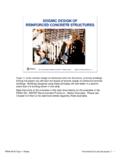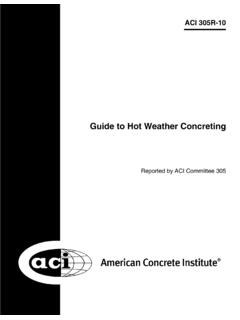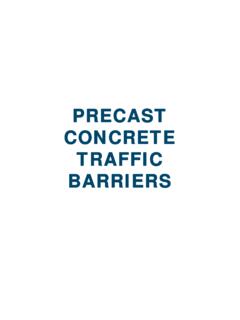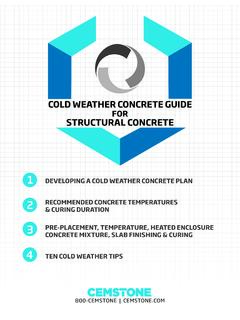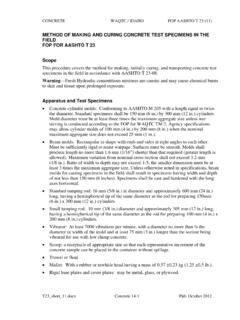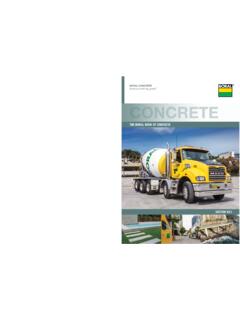Transcription of 228.1R-03 In-Place Methods to Estimate Concrete Strength
1 ACI supersedes ACI and became effective September 16, 2003, American Concrete rights reserved including rights of reproduction and use in any form or by anymeans, including the making of copies by any photo process, or by electronic ormechanical device, printed, written, or oral, or recording for sound or visual reproductionor for use in any knowledge or retrieval system or device, unless permission in writingis obtained from the copyright Committee Reports, Guides, Standard Practices, andCommentaries are intended for guidance in planning, designing,executing, and inspecting construction. This document isintended for the use of individuals who are competent toevaluate the significance and limitations of its content andrecommendations and who will accept responsibility for theapplication of the material it contains. The American ConcreteInstitute disclaims any and all responsibility for the statedprinciples.
2 The Institute shall not be liable for any loss ordamage arising to this document shall not be made in contractdocuments. If items found in this document are desired by theArchitect/Engineer to be a part of the contract documents, theyshall be restated in mandatory language for incorporation bythe Architect/Engineer. is the responsibility of the user of this document to establishhealth and safety practices appropriate to the specificcircumstances involved with its use. ACI does not make anyrepresentations with regard to health and safety issues and theuse of this document. The user must determine the applicabilityof all regulatory limitations before applying the document andmust comply with all applicable laws and regulations,including but not limited to, United States Occupational Safetyand Health Administration (OSHA) health and Methods to Estimate Concrete StrengthACI is provided on the use of Methods to Estimate the in-placestrength of Concrete in new and existing construction.
3 The Methods include:rebound number, penetration resistance, pullout, break-off, ultrasonic pulsevelocity, maturity, and cast- In-Place cylinders. The principle, inherent limi-tations, and repeatability of each method are reviewed. Procedures arepresented for developing the relationship needed to Estimate compressivestrength from In-Place results. Factors to consider in planning in-placetests are discussed, and statistical techniques to interpret test results arepresented. The use of In-Place tests for acceptance of Concrete is intro-duced. The appendix provides information on the number of Strength levelsthat should be used to develop the Strength relationship and explains aregression analysis procedure that accounts for error in both dependentand independent : coefficient of variation; compressive Strength ; construction; In-Place tests; nondestructive tests; safety; sampling; statistical 1 Introduction, p.
4 Need for In-Place tests during Influence of ACI Recommendations in other ACI Existing Objective of reportChapter 2 Review of Methods , p. Rebound number (ASTM C 805) Penetration resistance (ASTM C 803/C 803M) Pullout test (ASTM C 900) Break-off number (ASTM C 1150) Ultrasonic pulse velocity (ASTM C 597) Maturity method (ASTM C 1074) Cast- In-Place cylinders (ASTM C 873) Strength Combined SummaryReported by ACI Committee 228 Farhad AnsariAl Ghorbanpoor*John S. Popovics*Hermenegildo CaratinFrederick D. HeidbrinkSandor PopovicsNicholas J. Carino*Bernard H. HertleinRandall W. Poston*K. ChoiKal R. HindoAfshin SadriNeil A. CummingRobert S. JenkinsBryce P. SimonsAllen G. DavisKeith E. Kesner Patrick J. SullivanAldo DelahazaH. S. LewGeorge V. TeodoruRonald L. DillyKenneth M. Lozen*Woodward L. VogtDonald E. DixonLarry D. OlsonAlexander B. ZoobBoris DragunskyStephen P. Pessiki*Chair*Members of the task force that prepared the revision. Task force COMMITTEE REPORTC hapter 3 Statistical characteristics of test results, p.
5 Need for statistical Repeatability of test resultsChapter 4 Development of Strength relationship, p. New Existing constructionChapter 5 Implementation of In-Place testing,p. New Existing constructionChapter 6 Interpretation and reporting of results, p. Statistical Reporting resultsChapter 7 In-Place tests for acceptance of Concrete , Acceptance Early-age testingChapter 8 References, p. Referenced standards and Cited referencesAppendix, p. Minimum number of Strength Regression analysis with X-error (Mandel 1984) Standard deviation of estimated Y-value (Stone andReeve 1986) ExampleCHAPTER 1 ScopeIn-place tests are performed typically on Concrete within astructure, in contrast to tests performed on molded specimensmade from the Concrete to be used in the structure. Histori-cally, they have been called nondestructive tests becausesome of the early tests did not damage the Concrete . Over theyears, however, new Methods have developed that result insuperficial local damage.
6 Therefore, the terminology In-Place tests is used as a general category that includes thosethat do not alter the Concrete and those that result in minorsurface damage. In this Report, the principal application ofin-place tests is to Estimate the compressive Strength of theconcrete. The significant characteristic of most of these testsis that they do not directly measure the compressive strengthof the Concrete in a structure. Instead, they measure someother property that can be correlated to compressive Strength (Popovics 1998). The Strength is then estimated from apreviously established relationship between the measuredproperty and Concrete Strength . The uncertainty of the estimatedcompressive Strength depends on the variability of the in-placetest results and the uncertainty of the relationship betweenthese two parameters. These sources of uncertainty arediscussed in this tests can be used to Estimate Concrete strengthduring construction so that operations that require a specificstrength can be performed safely or curing procedures can beterminated.
7 They can also be used to Estimate concretestrength during the evaluation of existing structures. Thesetwo applications require slightly different approaches, soparts of this Report are separated into sections dealing withnew and existing variety of techniques are available for estimating thein-place Strength of Concrete (Malhotra 1976; Bungey1989; Malhotra and Carino 1991). No attempt is made toreview all of these Methods in this report; only thosemethods that have been standardized by ASTM arediscussed. Teodoru (1989) prepared a compilation ofnational standards on In-Place test Need for In-Place tests during constructionIn North American practice, the most widely used test forconcrete is the compressive Strength test of the standardcylinder (ASTM C 31/C 31M). This test procedure is relativelyeasy to perform in terms of sampling, specimen preparation,and Strength measurement. When properly performed, thistest has low within-test variation and low interlaboratoryvariation and, therefore, readily lends itself to use as a stan-dard test method.
8 The compressive Strength so obtained isused to calculate the nominal strengths of structuralmembers. Therefore, this Strength value is an essentialparameter in design carried out according to standard procedures,however, the results of the cylinder compression test repre-sent the potential Strength of the Concrete as delivered to asite. The test is used mainly as a basis for quality control ofthe Concrete to ensure that contract requirements are met. Itis not intended for determining the In-Place Strength of theconcrete because it makes no allowance for the effects ofplacing, compaction, or curing. It is unusual for the concretein a structure to have the same properties as a standard-curedcylinder at the same test age. Also, standard-cured cylindersare usually tested for acceptance purposes at an age of 28 days;therefore, the results of these tests cannot be used to determinewhether adequate Strength exists at earlier ages for saferemoval of formwork or the application of Concrete in some parts of a structure, such as columns,may develop Strength equal to the standard 28-day cylinderstrength by the time it is subjected to design loads.
9 Concretein most flexural members (especially pretensioned flexuralmembers) does not develop its 28-day Strength before themembers are required to support large percentages of theirdesign loads. For these reasons, In-Place tests are used toestimate the Concrete Strength at critical locations in a structureand at times when crucial construction operations are , some measure of the Strength of theconcrete in the structure has been obtained by using field-cured cylinders prepared and cured in accordance withASTM C 31/C 31M. These cylinders are cured on or in theIN-PLACE Methods TO Estimate Concrete under, as nearly as possible, the same conditions asthe Concrete in the structure. Measured strengths of field-cured cylinders may be significantly different from in-placestrengths because it is difficult, and often impossible, to haveidentical bleeding, consolidation, and curing conditions forconcrete in cylinders and Concrete in structures (Soutsos etal.)
10 2000). Field-cured specimens need to be handled withcare and stored properly to avoid misleading test schedules often require that operations suchas form removal, post-tensioning, termination of curing, andremoval of reshores be carried out as early as possible. Toenable these operations to proceed safely at the earliestpossible time requires the use of reliable In-Place tests toestimate the In-Place Strength . The need for such strengthinformation is emphasized by several construction failuresthat possibly could have been prevented had In-Place testingbeen used (Lew 1980; Carino et al. 1983). In-Place testingnot only increases safety but can result in substantial costsavings by permitting accelerated construction schedules(Bickley 1982a). Influence of ACI 318 Before 1983, ACI 318 required testing of field-curedcylinders to demonstrate the adequacy of Concrete strengthbefore removal of formwork or reshoring.
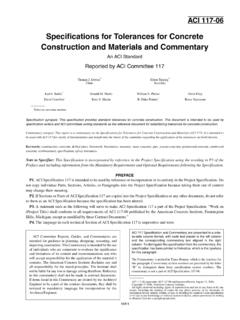


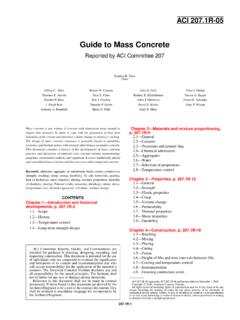

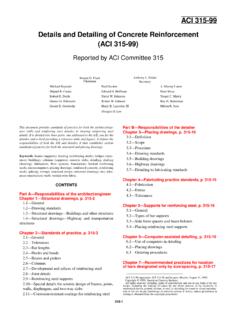
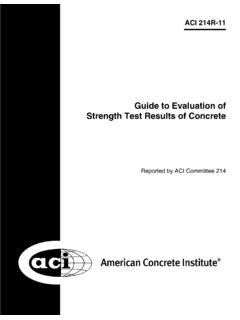

![6ITSVXIH F] %'- 'SQQMXXII - dl.mycivil.ir](/cache/preview/4/b/b/f/2/e/8/1/thumb-4bbf2e81b2b2df04c22714e49f0954ce.jpg)


